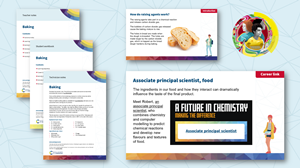Investigate the purposes of the ingredients and techniques used to make cupcakes
The investigation should take approximately one hour to complete in full. It was initially created for 11–14 year-old learners but can be adapted for other age groups.
Use in a sequence of timetabled lessons, science clubs or as part of an activity day. Carry the resource out in a food technology classroom or similar as learners will be baking and tasting cakes and eating is not allowed in science labs.
Learning objectives
- Describe the role of raising agents in baking.
- Explain why it is important to follow baking recipes carefully.
Guidance notes
Use slides 3–5 of the PowerPoint to introduce the use and purpose of raising agents.
In Activity 1, divide learners into six groups, A–F. Each group will follow a different method to bake some small cupcakes. Slide 7 introduces the basic ingredients needed in cake baking and slides 8–9 explain the experimental method. This is a good opportunity to talk about controls – why is only one ingredient changed in each method?

This resource was developed as part of the Chemistry for All project. The project was set up to explore and address barriers to participation in UK chemistry undergraduate study through a longitudinal project. Read the findings relevant to teachers, outreach providers, education policymakers and parents in the summary report, or download the full research report.
Activity 2 requires learners to consider the purpose of each of the ingredients. They will answer questions 1–4 in their student workbooks while they wait for their cupcakes to bake. This is a good opportunity to discuss chemistry careers in food.
In Activity 3, learners will taste and evaluate the cupcakes produced using each of the six methods.
Find the answers to all the activities in the teacher notes and slides.
Health and safety
Read our health and safety guidance and carry out a risk assessment before running any live practical.
Instruct learners to wear oven gloves when handling hot cupcake tins and aprons to help to protect clothes. The safety rules might be different where you live so it is worth checking local and school guidance. Be aware of any allergies and dietary requirements. If unsure, discuss any amendments with your food technology department.
More resources
- Encourage scientific thinking and working to improve evaluation skills by asking learners to complete the table as they experiment.
- Get 14–16 year-old learners more comfortable with concepts such as moles, ratios and reagents with cooking equations.
- Explore the chemistry of baking powder further with the background information and questions provided.
Careers
The Chemistry for All project found that recognising the value and importance of chemistry, and appreciating how chemistry can lead to interesting and well-paid jobs strongly related to learners’ future aspirations. Discover how chemistry can prepare learners to pursue apprenticeships, university courses and vocational routes, or browse job profiles and try our career options game from A Future in Chemistry.
Between Activities 2 and 3, link the context of the baking resource to careers by sharing Robert’s video job profile (available on slide 14 of the PowerPoint). He works as an associate principal scientist, combining chemistry and computer modelling to predict chemical reactions and develop new flavours and textures of food.
Find more activities like this, plus longer projects suitable for off-timetable days, science lessons or clubs on our Outreach resources hub.
Downloads
Baking student workbook
Editable handout | Word, Size 0.48 mbBaking student workbook
Handout | PDF, Size 0.4 mbBaking teacher notes
Editable handout | Word, Size 0.48 mbBaking teacher notes
Handout | PDF, Size 0.49 mbBaking technician notes
Editable handout | Word, Size 0.47 mbBaking technician notes
Handout | PDF, Size 0.33 mbBaking presentation slides
Presentation | PowerPoint, Size 2.31 mbBaking presentation slides
Presentation | PDF, Size 1.32 mb
Additional information
This resource was originally developed by the University of Reading to support outreach work delivered as part of the Chemistry for All project.



















No comments yet